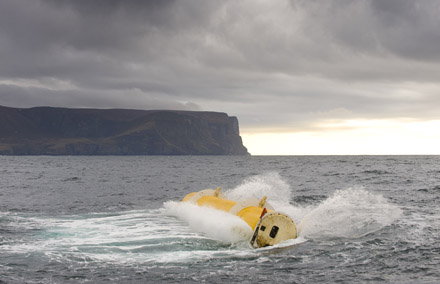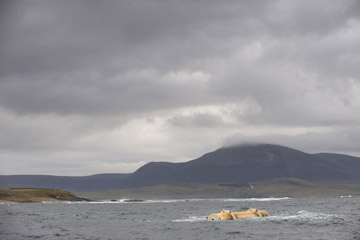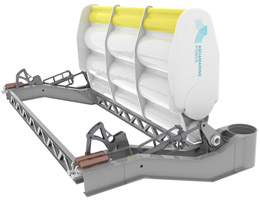Navigation
Research To Create New Wave Of Clean Energy Technology Underway
BAE Systems has joined forces with wave energy developer Aquamarine Power as part of a project worth almost £1 million to deliver cheaper, more reliable sources of clean energy for homes across the UK and beyond.
BAE Systems has joined forces with wave energy developer Aquamarine Power as part of a project worth almost £1 million to deliver cheaper, more reliable sources of clean energy for homes across the UK and beyond.
 |
| Oyster wave energy converter in operation. Videos showing the operation are at the at the end of this article. Photograph courtesy of Aquamarine Power |
The Technology Strategy Board awarded a £450,000 grant, which the partners match-funded, to support a 30 month research, development and demonstration project to enable large-scale commercial production of Aquamarine Power’s Oyster wave energy converter. The innovative device – a buoyant hinged flap – attaches to the seabed and moves backwards and forwards in the nearshore waves, pumping high pressure water onshore to drive a hydro-electric turbine, which then generates electricity for the National Grid.
 |
| Oyster in operation. Photograph courtesy of Aquamarine Power |
Under the partnership, engineers at BAE Systems usually involved in the design, repair and maintenance of complex naval systems, will work with Aquamarine Power to develop an intelligent diagnostic system and remote ballasting mechanism. Together, these innovations will drive down maintenance costs and help to maximize energy production, paving the way for this ground-breaking technology to be rolled out on a commercial scale to establish Oyster clean energy farms around the world.
Aquamarine Power’s innovative Oyster technology is designed to be installed at around 10 meters depth, 0.5km from shore. Aquamarine Power has already installed and tested its Oyster 1 demonstration device at the European Marine Energy Centre in Orkney, Scotland, where it generates electricity which is transmitted to the National Grid to power homes in the local area. It is estimated that a farm of 20 next generation Oyster 2 devices will generate enough energy to power more than 12,000 homes.
Kevin McLeod, Engineering Director at BAE Systems’ Surface Ships division, said: “This is a great opportunity for us to apply skills developed in naval design and the management of large complex maritime engineering programs to support the emerging marine energy industry.
“In working with Aquamarine Power as a partner, we are helping to pioneer commercial clean energy solutions that will help the UK meet its ambitious climate change targets.”
“The Oyster system works well,” says Aquamarine Power Chief Executive, Martin McAdam. “Our next step is to drive down the cost of electricity generated from wave power through improvements in Oyster reliability and reduced maintenance costs.
“BAE Systems is a fantastic company with extensive experience in marine systems performance modelling and analysis. Our companies are very different in size, but we share a passion for engineering excellence and a belief in the global potential of wave energy. We are grateful to the Technology Strategy Board for providing the grant funding which has enabled this collaboration to take place.”
 |
| Oyster 2 wave energy converter design. Image courtesy of Aquamarine Power |
Aquamarine Power’s innovative Oyster technology is designed to be installed at around 10 meters depth, 0.5km from shore. Aquamarine Power has already installed and tested its Oyster 1 demonstration device at the European Marine Energy Centre in Orkney, Scotland, where it generates electricity which is transmitted to the National Grid to power homes in the local area. It is estimated that a farm of 20 next generation Oyster 2 devices will generate enough energy to power more than 12,000 homes.
Iain Gray, Chief Executive of the Technology Strategy Board, said: “By 2050 we are going to have very different energy needs than we have today and we will be getting our energy from different sources. The UK is well placed to exploit wave and tidal stream energy resources with all of the coast line that we have, and it is expected this kind of technology will be an important part of the renewable energy mix needed in the future.
“We still need to prove which technological solutions will most successfully harness marine energy and we need to reduce the cost of the energy produced to make the technology competitive with other renewable energy solutions. So there are a range of technological challenges to address.”
BAE Systems is already involved in a number of initiatives to support the renewable energy sector. The defense company actively works with the wind farm industry to resolve issues about their disruption to radars. Its engineers designed the electrical distribution system for the largest land based wind farm in Europe at Whitelee and BAE Systems is also working with partners to develop an deepwater offshore wind farm design.
Aquamarine Power closed a £6 million funding round this year and has subsequently been awarded more than £3 million from the Scottish Government WATERS fund (Wave and Tidal Energy: Research, Development and Demonstration Support). The company is actively seeking a major investment partner and a strategic technology partner to take the Oyster device through to commercialization.
Aquamarine Power has won numerous national and international awards for innovation in the renewable energy sector including the Company Pioneer Award 2010 (EnergyOcean International) and the British Renewable Energy Award for best renewable energy product 2010 (Renewable Energy Association).
This news is from Aquamarine Power, July 26, 2010.
Note:
See related articles on Horizon International's Solutions Site at:
Nearshore Waves Ideal For Wave Energy Says New Scientist
£5.1M Government Funding Secured To Develop Wave Energy Device, Oyster 2
Hydro-electric Wave Energy Device “Oyster” Launched Off the Coast of Scotland
Oyster wave power device in operation.
Developed by Aquamarine Power.
Animation showing how the first demonstration Oyster 1 wave power device creates clean sustainable electricity from ocean wave energy. Find out more about Aquamarine Power and its Oyster wave power technology at http://www.aquamarinepower.com/
Search
Latest articles
Agriculture
- World Water Week: Healthy ecosystems essential to human health: from coronavirus to malnutrition Online session Wednesday 24 August 17:00-18:20
- World Water Week: Healthy ecosystems essential to human health: from coronavirus to malnutrition Online session Wednesday 24 August 17:00-18:20
Air Pollution
- "Water and Sanitation-Related Diseases and the Changing Environment: Challenges, Interventions, and Preventive Measures" Volume 2 Is Now Available
- Global Innovation Exchange Co-Created by Horizon International, USAID, Bill and Melinda Gates Foundation and Others
Biodiversity
- It is time for international mobilization against climate change
- World Water Week: Healthy ecosystems essential to human health: from coronavirus to malnutrition Online session Wednesday 24 August 17:00-18:20
Desertification
- World Water Week: Healthy ecosystems essential to human health: from coronavirus to malnutrition Online session Wednesday 24 August 17:00-18:20
- UN Food Systems Summit Receives Over 1,200 Ideas to Help Meet Sustainable Development Goals
Endangered Species
- Mangrove Action Project Collaborates to Restore and Preserve Mangrove Ecosystems
- Coral Research in Palau offers a “Glimmer of Hope”
Energy
- Global Innovation Exchange Co-Created by Horizon International, USAID, Bill and Melinda Gates Foundation and Others
- Wildlife Preservation in Southeast Nova Scotia
Exhibits
- Global Innovation Exchange Co-Created by Horizon International, USAID, Bill and Melinda Gates Foundation and Others
- Coral Reefs
Forests
- NASA Satellites Reveal Major Shifts in Global Freshwater Updated June 2020
- Global Innovation Exchange Co-Created by Horizon International, USAID, Bill and Melinda Gates Foundation and Others
Global Climate Change
- It is time for international mobilization against climate change
- It is time for international mobilization against climate change
Global Health
- World Water Week: Healthy ecosystems essential to human health: from coronavirus to malnutrition Online session Wednesday 24 August 17:00-18:20
- More than 400 schoolgirls, family and teachers rescued from Afghanistan by small coalition
Industry
- "Water and Sanitation-Related Diseases and the Changing Environment: Challenges, Interventions, and Preventive Measures" Volume 2 Is Now Available
- Global Innovation Exchange Co-Created by Horizon International, USAID, Bill and Melinda Gates Foundation and Others
Natural Disaster Relief
- STOP ATTACKS ON HEALTH CARE IN UKRAINE
- Global Innovation Exchange Co-Created by Horizon International, USAID, Bill and Melinda Gates Foundation and Others
News and Special Reports
- World Water Week: Healthy ecosystems essential to human health: from coronavirus to malnutrition Online session Wednesday 24 August 17:00-18:20
- STOP ATTACKS ON HEALTH CARE IN UKRAINE
Oceans, Coral Reefs
- World Water Week: Healthy ecosystems essential to human health: from coronavirus to malnutrition Online session Wednesday 24 August 17:00-18:20
- Mangrove Action Project Collaborates to Restore and Preserve Mangrove Ecosystems
Pollution
- Zakaria Ouedraogo of Burkina Faso Produces Film “Nzoue Fiyen: Water Not Drinkable”
- "Water and Sanitation-Related Diseases and the Changing Environment: Challenges, Interventions, and Preventive Measures" Volume 2 Is Now Available
Population
- "Water and Sanitation-Related Diseases and the Changing Environment: Challenges, Interventions, and Preventive Measures" Volume 2 Is Now Available
- "Water and Sanitation-Related Diseases and the Changing Environment: Challenges, Interventions, and Preventive Measures" Volume 2 Is Now Available
Public Health
- Honouring the visionary behind India’s sanitation revolution
- Honouring the visionary behind India’s sanitation revolution
Rivers
- World Water Week: Healthy ecosystems essential to human health: from coronavirus to malnutrition Online session Wednesday 24 August 17:00-18:20
- Mangrove Action Project Collaborates to Restore and Preserve Mangrove Ecosystems
Sanitation
- Honouring the visionary behind India’s sanitation revolution
- Honouring the visionary behind India’s sanitation revolution
Toxic Chemicals
- "Water and Sanitation-Related Diseases and the Changing Environment: Challenges, Interventions, and Preventive Measures" Volume 2 Is Now Available
- Actions to Prevent Polluted Drinking Water in the United States
Transportation
- "Water and Sanitation-Related Diseases and the Changing Environment: Challenges, Interventions, and Preventive Measures" Volume 2 Is Now Available
- Urbanization Provides Opportunities for Transition to a Green Economy, Says New Report
Waste Management
- Honouring the visionary behind India’s sanitation revolution
- Honouring the visionary behind India’s sanitation revolution
Water
- Honouring the visionary behind India’s sanitation revolution
- Honouring the visionary behind India’s sanitation revolution
Water and Sanitation
- Honouring the visionary behind India’s sanitation revolution
- Honouring the visionary behind India’s sanitation revolution

